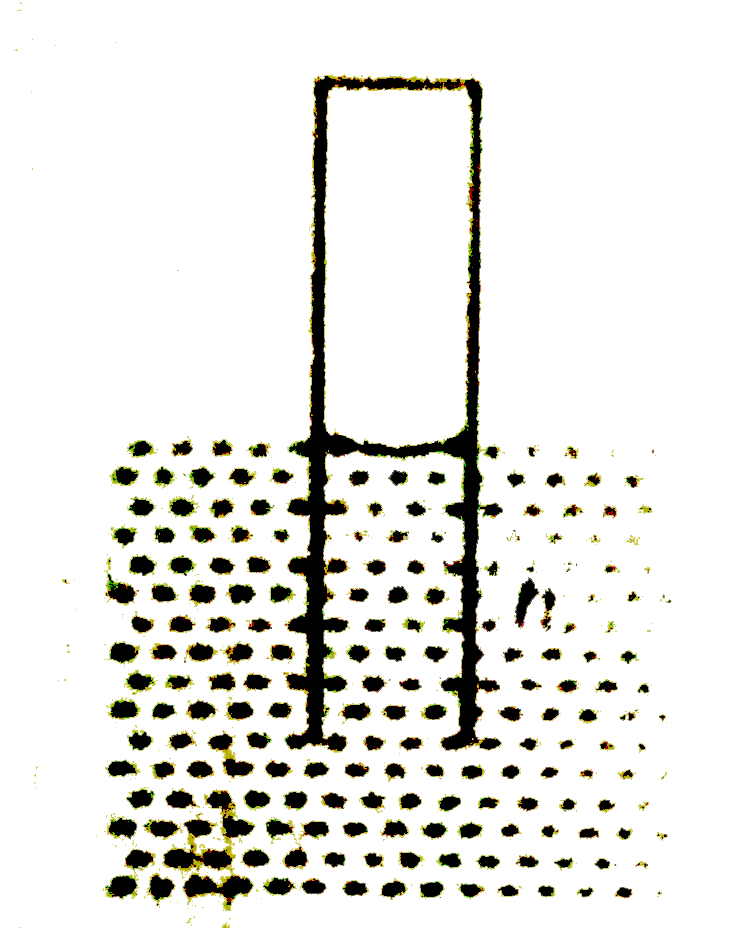A glass capillary of length l and inside radius r(r<<l) is submerged vertically into water. The upper end of the capillary is scaled. The atmospheric pressure is p0. To what length h has the capillary to be submerged to make the water levels inside and outside the capillary coincide. Assume that temperature of air in the capillary remains constant. (given, surface tension of water = T, angle of contact between glass water interface =0∘)

l(1+P0r4γ)
l(1−p0r4γ)
l(1−p0r2γ)
l(1+p0r2γ)
The correct Answer is:D

Let p. be the pressure of air inside the sealed capillary tube
here p.=(p0+2γr)
Using boyle.s law p0V0=p.V.
∴p0(lA)=p.(l−x)A⇒p.=p0ll−x ….(i)
Where A is the cross sectional area of capillary tube.
Now since level of water inside capillary coincides with outside ,
∴p.−p0=2γr
∴p0l(l−x)−p0=2γr (from eqn (i))
p0(ll−x−1)=2γr⇒p0x2γr(l−x)
⇒x=⎛⎜⎝1+lp0x2γ⎞⎟⎠
Topper's Solved these Questions
- BOOK - MTG-WBJEECHAPTER - BULK PROPERTIES OF MATTEREXERCISE - WB JEE PREVIOUS YEARS QUESTIONS (ONE OR MORE THAN ONE OPTION CORRECT TYPE)1videos
BULK PROPERTIES OF MATTER
- BOOK - MTG-WBJEECHAPTER - BULK PROPERTIES OF MATTEREXERCISE - WB JEE WORKOUT (ONE OR MORE THAN ONE OPTION CORRECT TYPE )10videos
BULK PROPERTIES OF MATTER
- BOOK - MTG-WBJEECHAPTER - ATOMS MOLECULES AND CHEMICAL ARITHEMETIC EXERCISE - WB JEE PREVIOUS YEARS QUESTIONS CATEGORY 1: SINGLE OPTION CORRECT TYPE (1 MARK)3videos
ATOMS MOLECULES AND CHEMICAL ARITHEMETIC
- BOOK - MTG-WBJEECHAPTER - CURRENT ELECTRICITY EXERCISE - WB JEE PREVIOUS YEARS QUESTIONS21videos
CURRENT ELECTRICITY
Similar Questions
A uniform capillary tube of length l and inner radius r with its upper end sealed is submerged vertically into water. The outside pressure is P0 and surface tension of water is T. What will be the value of c, when water levels inside and outside capillary coincide, length of capillary submerged into water is given by 2l(2+Pr0cT).
View SolutionA glass capillary sealed at the upper end is of length 0.11m an internal diameter 2×105m. The tube is immersed vertically into a liquid of surface tension 5.06×10−N/m. To what length the capillary has to be immersed so that the liquid level inside and outside the capalliary becomes the same. What will happen to water level inside the capillary if the seal is now broken?
View Solution
Knowledge Check
- Question 1 - Select One
A galss capillary length l=11cm and inside diameter d=20μm is submerged vertically into water. The upper end of the capillary is sealed. The outside pressure is considered to be 1×105Nm2 . To what length has the capillary to be submerged to make the water levels inside and outside the capillary coincide?
A1.2 cmB2.4 cmC1.4 cmD2.8 cm - Question 2 - Select One
Water rises in a glass capillary tube due to
Asurface tension of waterBcohesive force of glass moleculesCtemperature of waterDadhesive force between water molecules and the walls of the glass tube - Question 3 - Select One
Water rises in a glass capillary tube due to
Asurface tension of waterBcohesive force of glass moleculesCtemperature of waterDadhesive force between water molecules and the walls of the glass tube
In capillary pressure below the curved surface of water will be
View SolutionWhen a capillary is dipped in water, water rises to a heig ht h . If the length of the capillary is made less than h , then
View SolutionOne end of a glass capillary tube with a radius r is immersed into water to a depth of h The surface tension of water is s and atmospheric pressure is p0 . What pressure is required to blow an air bubble out of the lower end of the tube? Density of water is ρ
View SolutionIn a capillary tube of radius 'R' a straight thin metal wire of radius ' r ' (R>r) is inserted symmetrically and one end of the combination is at the same level . The rise of water in the capillary tube is
View SolutionIf a capillary tube of diameter 0.4 m is dipped vertically into water, then the height to which water rises in the capillary tube will be ,
View Solution
